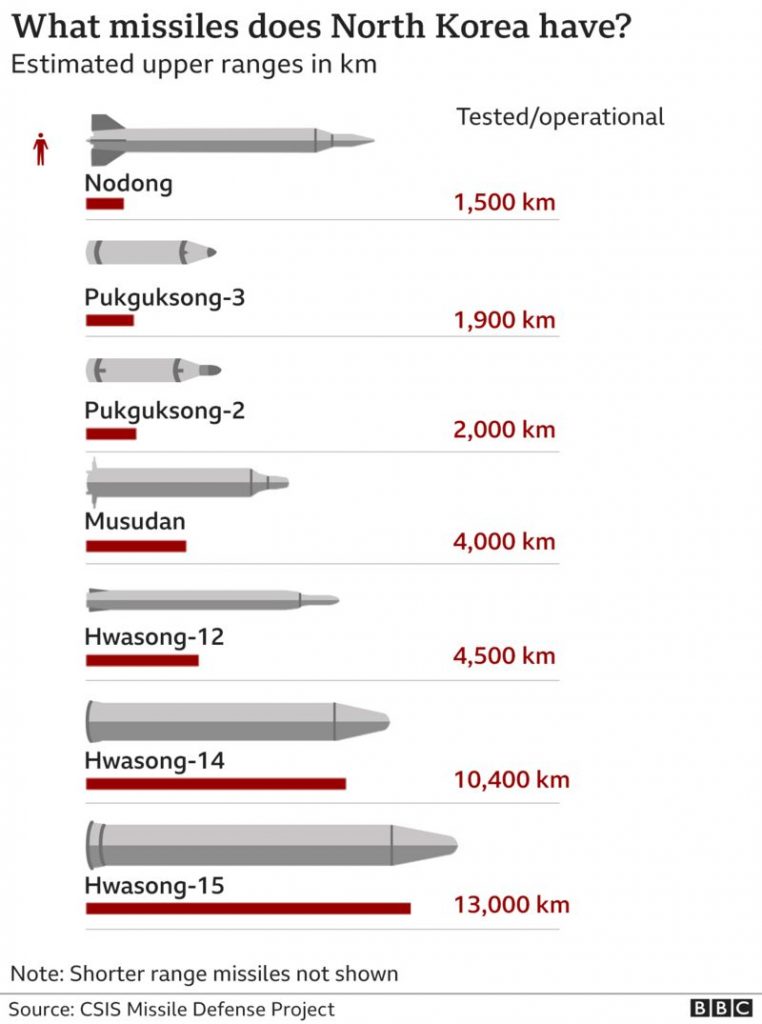North Korea fires another missile, longest range since 2017

North Korea fired what is presumed to be its longest range ballistic missile since 2017 on Sunday, an escalation of its weapons program and a possible sign of larger tests to come, according to South Korea’s President.
According to CNN reports, both the South Korean and Japanese governments reported the launch of an Intermediate Range Ballistic Missile (IRBM), with officials in Tokyo saying the missile reached a height of 2,000 kilometers (1,243 miles) with a range of 800 kilometers (497 miles), before falling into waters off the east coast of the Korean Peninsula.
“If the missile were fired at a normal apogee, its range would be up to 3,500 kilometers to 5,500 kilometers, making it an Intermediate Range Ballistic Missile and North Korea’s longest test since 2017,” Joseph Dempsey, research associate for defense and military analysis at the International Institute for Strategic Studies in London, told CNN Sunday.
A US assessment also found the launch to be an IRBM, most likely a KN-17, also known as a Hwasong-12, according to a US official with direct knowledge.
An IRBM would be able to strike the US territory of Guam in the Pacific Ocean.
Sunday’s launch is Pyongyang’s sixth ballistic missile launch in 2022 and seventh missile test overall.

Related
The Kim Jong Un regime is ramping up its missile testing in 2022, and has said it will bolster its defenses against the United States and evaluate “restarting all temporally suspended activities,” according to North Korea’s state-run news agency KCNA.
Dempsey said Sunday’s launch shows North Korea may be doing just that.
“Following their 2018 self-imposed moratorium on long range and nuclear testing, they have limited ballistic missiles tested to short range (SRBM) and medium range (MRBM),” Dempsey said.
The sense of all the recent tests is Kim “has a desire to test out his inventory” and doesn’t care if Washington sees it, the US official said.
South Korean President Moon Jae-in said Sunday the North is coming close to scrapping the moratorium on Intercontinental Ballistic Missiles — weapons which in theory could strike the US mainland — and nuclear testing.
Moon, who convened an emergency National Security Council meeting following Sunday’s launch, said the North is showing a similar pattern to 2017, when testing began with IRBMs, before moving to long range ballistic missile launches.
Dr Daniel Pinkston, a lecturer in international relations, told the BBC there were four main reasons why North Korea tests missiles: for engineering purposes to test new systems; for military exercises; for political signalling to different audiences; and as an advertisement for foreign buyers.
North Korea may be signalling to big powers such as China, the US and the UN Security Council, but also regional foes and also the Korean peninsula, he said.
“There’s a South Korean presidential election coming up in just over a month, so this is consistent with their past behaviour to try and intimidate South Korea and the incoming president,” said Dr Pinkston, from Troy University and who lives in South Korea.
“And then there’s the domestic audience inside North Korea which I think a lot of people underestimate, for that audience inside North Korea this is a way of signalling strength and resolve and the power of the leadership.”
On Thursday, North Korea fired what were presumed to be two short-range ballistic missiles into the seas off the nation’s east coast.
Two days before that, it fired what were believed to be cruise missiles into the same waters.
On January 17, Pyongyang test-fired “tactical guided missiles,” which are short-range ballistic missiles, KCNA said.
North Korea claimed to have successfully test-fired hypersonic missiles on January 5 and 11, and then what were presumed to be short-range ballistic missiles from a rail car on January 14.
Pyongyang is barred by international law from developing ballistic missiles and nuclear weapons.
After the rail car test, a North Korean Foreign Ministry spokesperson admonished Washington for its posture against Pyongyang’s weapons development. “If the US adopts such a confrontational stance, the DPRK will be forced to take stronger and certain reaction to it,” the spokesman said, referring to the country by its official name, the Democratic People’s Republic of Korea.
In a recent statement carried by KCNA, a spokesperson defended North Korea’s right to bolster its arms, saying its “recent development of new-type weapons was just part of its efforts for modernizing its national defense capability.”
Culled from CNN and BBC

